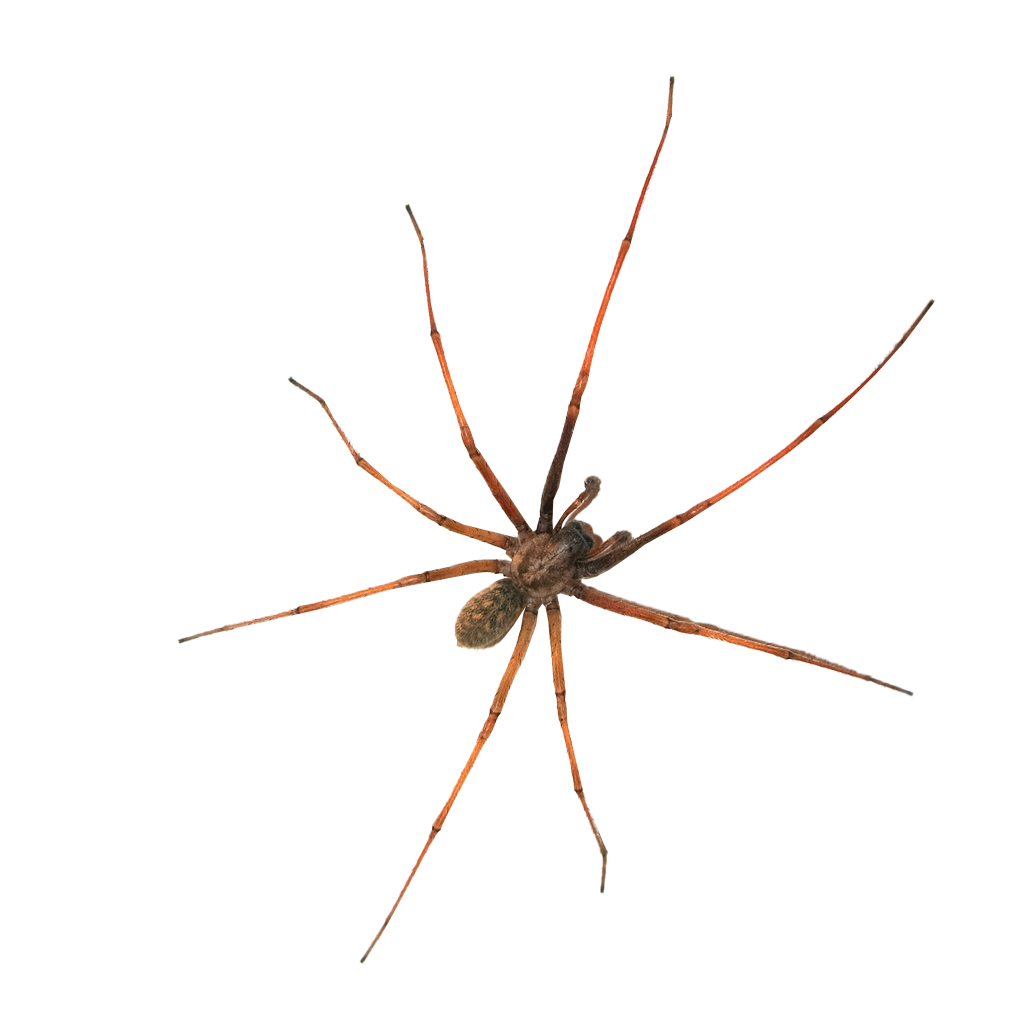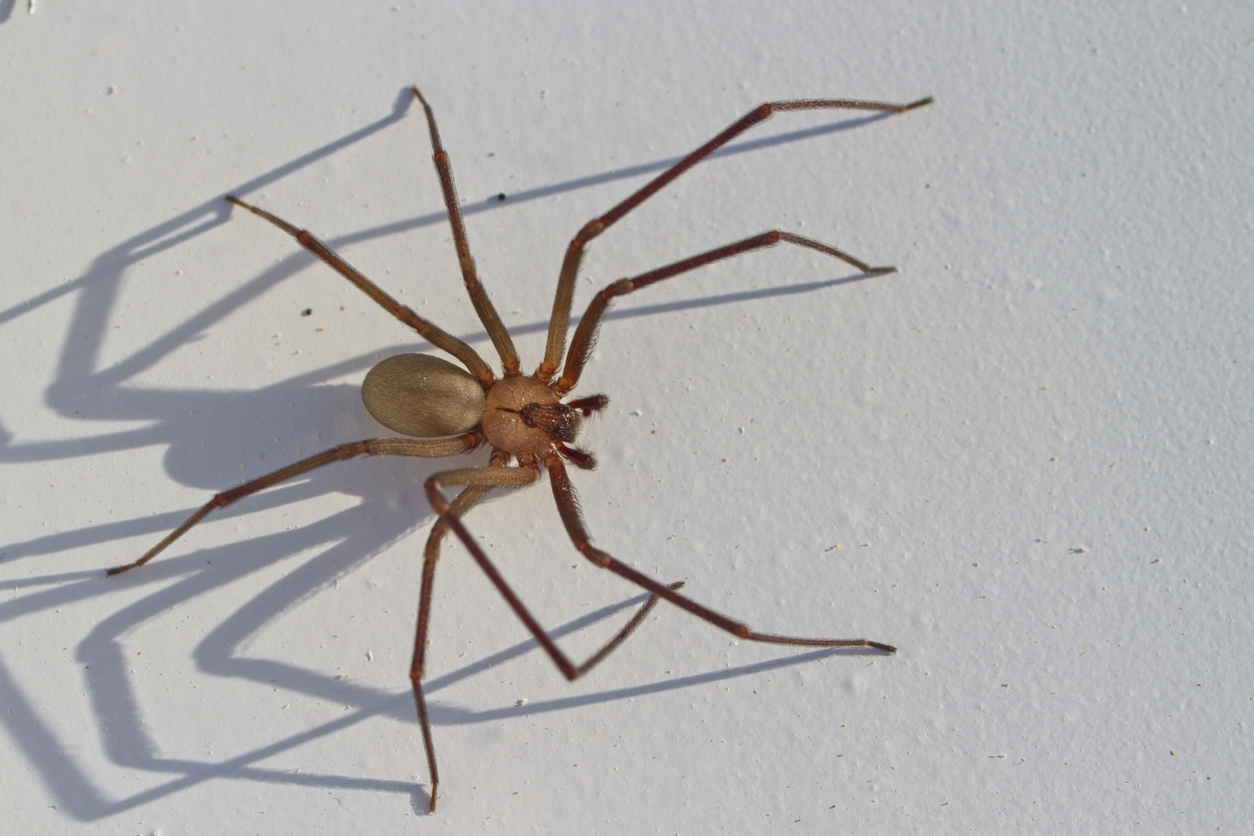Brown Recluse Spiders
Common Pest: Brown Recluse Spiders
All spiders are venomous; however, not all spider venom is toxic to humans. In fact: a Daddy Long Legs (not a true spider) has venom which is approximately 120 times more toxic to its prey than any other spider in North America, but this “spider” is completely harmless to humans. Unfortunately, we are not so lucky when it comes to a chance encounter with a Brown Recluse Spider.
Spiders inject venom into their prey through surgical like mouthparts (fangs)
The initial stage of toxin results in paralysis, and then venom begins digesting their victims almost instantly. Once liquefied, they draw the digested bodily fluid out through the same needle like appendage, turning a previously healthy grasshopper, for example, into a giant bug Slurpee. This killing technique is common to all spider species.
By virtue of our body mass, people are not on the menu for spiders and their venom is not adapted to paralyzing and digesting an object of our size. Large species of spiders like tarantulas and goliath spiders can prey on larger insects, and in some cases, small animals. However, food for a spider is generally limited to less than one ounce.
Spiders inject venom into their prey through surgical like mouthparts (fangs)
The initial stage of toxin results in paralysis, and then venom begins digesting their victims almost instantly. Once liquefied, they draw the digested bodily fluid out through the same needle like appendage, turning a previously healthy grasshopper, for example, into a giant bug Slurpee. This killing technique is common to all spider species.
By virtue of our body mass, people are not on the menu for spiders and their venom is not adapted to paralyzing and digesting an object of our size. Large species of spiders like tarantulas and goliath spiders can prey on larger insects, and in some cases, small animals. However, food for a spider is generally limited to less than one ounce.

Considering spiders inhabit the entire planet, (except Antarctica), contact with people is inevitable. Venom, by its very nature is toxic, so the bite from a spider can have adverse results. Humans are only seriously affected by the venom of a few species of spiders, the Brown Recluse being one of them. Many factors will influence the reaction a person will have in the event a bite should occur. Toddlers and the elderly are far more susceptible to having a bad reaction to a spider bite than a healthy 200 lb. man. Other factors may include overall health, the vitality of one’s immune system, body mass, and sex.
An adult Brown Recluse Spider is about the size of a quarter
With its legs extended, is light brown in color (they may vary in shades of tan to brown), has three pairs of eyes (all other spiders have four pairs), and it’s most distinctive feature is a violin-shaped marking on its cephalothorax, with the neck of the violin pointing towards the abdomen. The violin shape marking gives rise to the nicknames fiddle back, brown fiddler and violin spider.
Spiders are divided into two large groups by virtue of how they hunt for food. Passive spiders locate themselves near their food source, and spin a web in attempts to snare an unsuspecting insect as it passes by. An active hunter is a spider which actively hunts for a food source, like a lioness stalking its prey in the desert. They remain in hiding and seamlessly blend in with the background. When they spot a potential meal, they ambush their prey or run it down as the opportunity presents itself. Brown Recluse Spiders are members of the latter group and therefore do not spin webs.
An adult Brown Recluse Spider is about the size of a quarter
With its legs extended, is light brown in color (they may vary in shades of tan to brown), has three pairs of eyes (all other spiders have four pairs), and it’s most distinctive feature is a violin-shaped marking on its cephalothorax, with the neck of the violin pointing towards the abdomen. The violin shape marking gives rise to the nicknames fiddle back, brown fiddler and violin spider.
Spiders are divided into two large groups by virtue of how they hunt for food. Passive spiders locate themselves near their food source, and spin a web in attempts to snare an unsuspecting insect as it passes by. An active hunter is a spider which actively hunts for a food source, like a lioness stalking its prey in the desert. They remain in hiding and seamlessly blend in with the background. When they spot a potential meal, they ambush their prey or run it down as the opportunity presents itself. Brown Recluse Spiders are members of the latter group and therefore do not spin webs.
Brown Recluse Spiders are able to remain dormant for long periods of time and are actually shy in nature, hence their name. They avoid spinning webs so other more aggressive insects don’t track them, in case the need to flee the scene becomes necessary. They primarily forage at night.
Brown Recluse spiders live primarily in the south central region of the United States. They range from Missouri up to the lower part of Ohio down to the gulf and from eastern Texas through Oklahoma to about Indiana. The habitat of Brown Recluse Spiders can be in wood piles, sheds, garages, bushes, mulch beds, landscape areas and rotting tree bark. In structures they can be found in air plenums, attics, cellars closets, near toilets, behind baseboards and window casings and other places that are generally dry and undisturbed. The primary food source of Brown Recluse Spiders is silverfish, firebrats, crickets, cockroaches and other soft-bodied insects.

How then, does a mostly shy, nocturnal insect come into contact with humans?
When isolated areas are disturbed and the insect feels threatened, a bite will occur by virtue of self-defense. Ninety percent (90%) of Brown Recluse Spider bites occur while a person is sleeping. We roll over on them during sleep cycles, press them against our skin and they bite out of self-defense. The best way to avoid being bitten by a Brown Recluse Spider is to shake out seasonally stored clothes before wearing them, wipe out shoes that are not worn regularly, remove hats from storage and check under the headband and inspect the garment, turn shirt and coat sleeves inside out before wearing, break down cardboard boxes, store products in plastic bins and most importantly, cycle bedding as often as possible. Flip your mattresses regularly, vacuum around the bed, headboard, frame and mattresses and wash bed linens on a regular basis. Vacuum under furniture and along baseboards. Disturb their habitat in your home; make your environment as inhospitable as possible to this spider.
There is a wide range of reactions to a bite from a Brown Recluse Spider, which can range from minor to severe, and in some cases, very traumatic. The venom penetrates several epidermal layers, damaging soft tissue and stripping away your body’s natural layer of protection, leaving a person susceptible to virus and infection. As your body attempts to repair damage to the affected tissue, the residual effect of the toxin continually erodes any new skin growth. The toxic reaction is called necrosis, which in some cases can last several months to a year. Venom can potentially spread to an area about ten inches in diameter.
Symptoms of a bite can include nausea, vomiting, fever, rashes and muscle and joint pain. Often, bites may not be discovered immediately, nor will they always become painful and most don’t result in necrosis. However, because the Brown Recluse bears a potentially deadly hemotoxic venom, when you think a bite may have occurred, we strongly suggest you not procrastinate and seek immediate medical attention. Remember the old adage, “An ounce of prevention is worth a pound of cure.”
Frequently treating your home in accordance with a preventative program by the professional pest management team of Bugs By Brian® will eliminate a food source and further aide in reducing the population of Brown Recluse Spiders in and around your home or office.
St. Louis, Missouri
Email: scheduling@bugsbybrian.com
Call: (636) 394-0101
Location: 1401 Marsh Ave., Ellisville MO 63011
Melbourne, Florida
Email: scheduling@bugsbybrian.com
Call: (321) 674-1665
Location: 3830 S. Highway A1A Suite, 4135 Melbourne Beach, FL 32951
Ready to get started?
We offer free, no obligation estimates for all our pest control services.
Follow us on our social media plateforms


